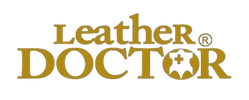![]() Leather Hydrating Conditioner 3.3 by Leather Doctor® is a professional-grade, pH 3.3 aqueous surfactant solution designed to clean, hydrate, relax, restore, and condition leather’s internal structure.
Leather Hydrating Conditioner 3.3 by Leather Doctor® is a professional-grade, pH 3.3 aqueous surfactant solution designed to clean, hydrate, relax, restore, and condition leather’s internal structure.
- Based on tannery science, this unique formula replicates the hydration stage of leather pre-conditioning, making it essential before effective fatliquoring with Fatliquor 5.0.
When leather becomes dry, stiff, or shrunken, the fibers collapse and bond together.
- Hydrator 3.3 penetrates deeply, rehydrates the collapsed fibers, balances the pH, conditions and prepares the structure for deep fat and oil conditioning.
- It also helps suspend and wick out impurities such as body oils, sweat, alkaline residues, and embedded soiling that compromise softness and flexibility.
Unlike water alone, Hydrator 3.3 reduces surface tension, ensuring deeper fiber penetration and uniform hydration.
- This critical pre-conditioning step restores suppleness, prevents patchiness, and maximizes the effectiveness of Fatliquor 5.0.
![]() Hydrator 3.3 Key Features & Benefits:
Hydrator 3.3 Key Features & Benefits:
-
Rehydrates Stiff or Collapsed Fibers – Restores essential moisture to dried-out or aged leather.
-
Prepares for Fatliquoring – Opens the leather’s fiber structure so Fatliquor 5.0 can penetrate and bond effectively.
-
Balances pH (3.3) – Realigns ionic charges to prevent alkaline damage and improve fatliquor bonding.
-
Suspends & Flushes Impurities – Helps wick out sweat, body oils, soiling, and chemical residues from within the fibers.
-
Restores Suppleness & Softness – Reduces stiffness and ensures even conditioning results without patchiness.
-
Tannery-Science Formula – Replicates the professional hydration step used in tanning and re-tanning processes.
-
Versatile Use – Suitable for vachetta, nubuck, suede, aniline, full-grain, semi-aniline, vegetable-tanned and hair-on-hide leather.
![]() Why Use Before Fatliquor 5.0?
Why Use Before Fatliquor 5.0?
1️⃣ Reopens Collapsed Fibers – Hydrator 3.3 relaxes tight, stiff fibrils so softening fat and oils can penetrate.
2️⃣ Restores pH Balance – Its mild acidity (pH 3.3) optimizes leather’s ionic structure for fatliquor bonding.
3️⃣ Flushes Contamination – Promotes wicking action to lift out impurities that interfere with even conditioning.
⚖️ Hydrator 3.3 softens by hydration. Fatliquor 5.0 softens by nourishment.
- Together, they restore leather’s strength, flexibility, and resistance to cracking.
![]() Typical Uses
Typical Uses
-
Pre-conditioning before applying Fatliquor 5.0 or Fatliquor 5.0 Plus
-
Rehydrating stiff, shrunken, or aged leather
-
Flushing out suspended body oils, sweat, or chemical residues
-
Restoring softness before/after structural leather repairs
-
Correcting pH imbalances caused by sweat or alkaline cleaners
![]() Suitable For
Suitable For
✅ Vachetta
✅ Nubuck
✅ Suede
✅ Aniline
✅ Full-Grain
✅ Semi-Aniline
✅ Vegetable-Tanned
✅ Hair-on-Hide
![]() Instructions for Use
Instructions for Use
-
Dilute concentrate at 1:25 ratio with distilled water.
-
Pre-test in an inconspicuous area.
-
Apply generously to cleaned leather or suede.
-
For thorough saturation, work into reverse side, stitching, seams, or perforations.
-
Optional: Cover with saturated towel wrap for 1–48 hours dwell.
-
Allow impurities to wick out, blot away while wet, or erase when dry (for nubuck/suede).
-
Continue with Fatliquor 5.0 while leather is still damp, massaging during drying for suppleness.
Updated: on April 8, 2025 | July 4, 2025 | August 11, 2025 | November 22, 2025 by Roger Koh
5 Reviews Hide Reviews Show Reviews
-
Hydrator 3.3
Wow! It’s amazing and a miracle. When I first saw the bottles I thought there was very little in the hydrator 3.3 bottle but it and the Fatliquor 5.0 were easy to mix and apply and they completely restored the zebra skin !!! I wish I knew about this product line when I first bought the zebra foot stool. If I ever need it again - without question, I will be back as a customer. The skin was starting to get stiff and hard… But these products totally restored the vitality and flexibility of the skin to its initial form. Amazing
-
this is the lifeblood of leather!
This leather hydrator is very good. It says that this is a pre conditioner or relaxant to leather surface for easy penetration of the following products.. I've tried applying this to my shoes, spraying a lot of it outside and brushing and spreading it.. I was worried about the suede part but it seems the hydrator is wetting the leather surface AND the suede altogether with just applying it OUTSIDE.. and now my shoe is very soft, and no crease left at all. I actually use hydrator 3.3 and fatliquor 5.0 for my shoes, and added a top coat after it's dry. Just be patient while doing your conditioning.
-
Great for restoring my leather sofa
The Hydrator is amazing and breathes a new life of hydration into your leather. My sofa was dry as could be and I had no idea until I started using this.
-
saves dried soft leather handbag
I used this to hydrate and save a high end leather handbag, brought it back with also using the fatliquor after the hydrater, sure helps the leather come back!!
-
Awesome product, great for hydrating high-end leather
I purchased pull-up wax leather furniture several years ago, promised by the high end retailer that they would never need anything - the wax pull up effect protected and prevented them from any maintenance. Wrong! After a few years, I was brave enough to try using products on my sofa and couldn't be happier. Roger guided us patiently through the process and now I'm back for a refill! Great product











